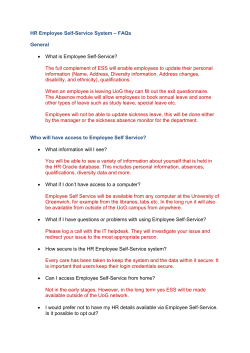
The Top Three Myths of Knowledge Management for Customer Service
IR KNOWLEDGE SERIES The Top Three Myths of Knowledge Management for Customer Service (Why KM is Hurting Your Customers, and What You Can Do About It) “The definition of insanity is doing the same thing over and over again and expecting different results” – Albert Einstein The Top Three Myths of Knowledge Management for Customer Service (Why KM is Hurting Your Customers, and What You Can Do About It) For years now, the Knowledge Management industry has been laboring under the misguided notion that when it comes to customer and self-service, content (often in the form of documents) is king. The more you have, (and the more efficiently you can index what you have by keyword), the better. This rather insular notion is at the heart of why KM is hurting the customer experience for many organizations. The bottom line is that Customer Relationship Management (CRM), Content Management (CMS & ECM) and intelligent search solutions all get a failing grade when evaluated against today’s customer and eService challenges. As a result, many corporate efforts designed to enhance self and e-Service options often fail the very people they were designed to help: the end customers. Further compounding the problem is the fact that most of the solutions in the marketplace apply similarly flawed approaches to the management and delivery of content for customer service (usually in the form of indexed key words sprinkled across multiple documents). Unfortunately, this often leads to dissatisfied customers being forced to engage the organization through higher cost channels, or worse yet, engage the competition. How we as an industry came to be where we are is not surprising really. In a typical fortune 500 company there are hundreds of thousands of “digital artefacts” representing the internal “knowledge” of the organization. In addition, many of these same organizations host thousands of web pages on both private and public facing company sites. A consumer from our perspective is anyone who consumes or utilizes the information internally or externally 1 Typically, this collection of “artefacts” is what is captured by CRM and ECM solutions, indexed with search tools and delivered under the guise of knowledge management. Unfortunately, many of these artefacts have little benefit to the individual who is attempting to answer a question. It’s likely not a surprise for those in the industry to hear that when in inquiry mode, customers want answers, not documents to search through, or lists of possible answers that may or may not help them. Customers want answers, not documents to search through, or lists of possible answers that may or may not help The use of most CRM, ECM or CMS technologies to deliver customer self-service or eService delivers results from a content-centric, versus consumer centric1 point-of-view. Under this paradigm, the delivery of information ceases to be all about the customer, and becomes all about the content. The reality is that at the moment, the KM industry is boiling the proverbial ocean, and approaching the problem from the wrong vantage point. In a customer service or self-service scenario, most requisite knowledge can be effectively encapsulated into a much smaller digital footprint by focusing on the nature of the question, not the nature of the answer. 1 The Top Three Myths of Knowledge Management for Customer Service (Why KM is Hurting Your Customers, and What You Can Do About It) Customers Want Answers, Not Documents By approaching the problem from the consumer perspective (i.e. I want short, succinct answers to my questions, not documents to search through), we drive up engagement and satisfaction, drive down delivery costs and satisfy the customer in the channel they chose to engage us in – thereby building trust. Here are the Top Three Myths of Knowledge Management as they relate to customer service. 1. Existing content captured in ECM and CMS systems is valuable to customers 2. Content can be applied readily to growing external and internal customer channels 3. Search-based paradigms are the best ways to connect customers to answers In the end this does not mean that your knowledge management initiatives are dead, or that you need to toss out existing products. It does however mean that you need to relieve the customer from the complexity of your underlying content and deliver a single answer to their question. This capability underscores the key requirement of customer centric service, particularly in today’s rapidly expanding SCRM environment. The KM industry is boiling the proverbial ocean, approaching the problem from the wrong vantage point 2 The Top Three Myths of Knowledge Management for Customer Service (Why KM is Hurting Your Customers, and What You Can Do About It) Myth #1: The “Value” of Existing Content As Freek Vermeulen noted in a recent blog entry, “What we sort of forgot in the torrent of “knowledge euphoria” was that this stuff can also come at a cost. The cost of actually finding it in t he jungle of corporate databases.”2 In a typical fortune 500 environment, the combination of electronic documents plus web site pages adds up to a staggering, largely unmanageable amount of content. Consider, for example, that the average number of customerfacing web pages managed by companies in the financial services sector averages at more than 11,000 and in telecommunications, that number climbs to 64,000! Typically, this is only a portion of the content managed, indexed and provided to customers as a means of answering their questions. Frustrating Experience This is why, as a customer, a quick attempt to find information for “cancelling a check” on leading financial services sites brings back 72 results in one, 48 in another and 40 from another without an appropriate relevant answer in the first several pages of results – not exactly an ideal customer experience. This approach to customer self- service drives down consumer productivity and is counterproductive to everything self-service should stand for. Many major corporations can satisfy the needs of both their customers and agents with between 300-700 pieces of content, not 30,000-70,000 The problem becomes even more vexing when we add this enormous pile of content to internal facing electronic repositories that are typically used to augment content for internal teams. Professors Martine Haas from The Wharton School and Morten Hansen from INSEAD recently posted an article entitled “Does Knowledge Deliver on its Promises”.3 In this article they outlined a study on teams in a consulting firm that were using expert knowledge repositories to compete on bids for new business contracts (interestingly, many internal customer service professionals, including call center, chat and email agents depend on similar internal knowledge content to educate and deliver answers). The advice provided from this use case research? “Shut down your expensive document databases; they tend to do more harm than good. They are a nuisance, impossible to navigate, and you can’t really store anything meaningful in them anyway.” Most organizations currently have tens, if not hundreds of thousands of pieces of information, comprised of both relevant and irrelevant electronic content. These same organizations are struggling to leverage these expansive content repositories as a means of supporting customer and service agent productivity. One of the key issues is that the answers to common customer and service agent questions are also buried in the content (where multiple answers to key questions arise but force the content consumer to select and scan to uncover it). In working with our customers, we often find that many major corporations can satisfy the needs of both their customers and agents with between 300 to 700 pieces of content at the most, not 30,000 to 70,000. Many organizations applying solutions to this problem turn to components of their CRM, CMS/ECM or Intelligent Search products to fundamentally categorize and index this growing content. These hundreds of thousands of documents are not effective in delivering the right answer through customer service channels. 2 3 http://blogs.harvardbusiness.org/vermeulen/2009/03/when-knowledge-management-hurt.html http://knowledge.wharton.upenn.edu/article.cfm?articleid=1841 3 The Top Three Myths of Knowledge Management for Customer Service (Why KM is Hurting Your Customers, and What You Can Do About It) Myth #2: Content can be Applied Readily to Growing Channels In many cases, the content being captured and delivered to an inquiring customer has little to no relevance to that consumer, or to the channel they choose to utilize. The challenge with the everexpanding communication landscape is that each channel has unique needs for content delivery. Is it effective, or even practical, to deliver information via mobile phone, or social media forums in the same way you would in a call center, or email platform? Although the latest “business process document for policy cancellation” is fascinating reading, a customer asking “How do I cancel a policy” likely does not want to read your five page PDF outlining the business processes on their cell phone. Let’s further examine the “cancel a policy” example from a multi-channel viewpoint: • In a call center agent’s hands, this knowledge might include the “answer” that also offers procedures for client retention (including special offers) which would not be included in the self-service area, and certainly not in the original document. • For the same customer asking this question on a web site, the “answer” may be an escalation to a specialty group to retain the customer (see item 1 above) using click-to-call or chat. • For the same customer asking this question via Mobile or SMS, the answer may be an immediate call back to the customer, or an abridged answer with external links to additional content. In our analysis the answers to customer questions all may share a core message; however each should be effectively purposed for the channel into which it is delivered. If you are intent on delivering a truly customer-centric self-service and eService strategy, the requirement is to extract the “answers” (and not the content). It is not about the 10,000 electronic documents that might have relevancy, but the 300 specific answers within the content that actually do. Re-purposing these answers for the selected channel they are delivered through can be a quick and effective method of handling over 90% of all incoming questions – whether through web self-service, contact center (voice, email and chat) or newer mobile and social media channels. A customer does not likely want to read your 5-page PDF on business processes while on their cell phone 4 The Top Three Myths of Knowledge Management for Customer Service (Why KM is Hurting Your Customers, and What You Can Do About It) Myth #3: Search is the Best Way to Connect Customers to Answers What is it that the consumer is looking for at the end of the day? Simply put, they want answers to their questions. In most cases by the time a consumer reaches your web site or call center they are goal-oriented, not research-oriented. In a recent Jupiter study related to the web, a lack of accuracy and relevancy in search results continue to be the main issue for users in a self-service environment. In fact, 44% stated that search could not understand their real questions and 35% said the results were unrelated to the question.4 Most consumers are doing a lot more “searching” than “finding” when trying to self-serve What should be most concerning is that 87% of site visitors have left a web site when they could not find the information they sought. Four of the five top reasons for exiting a site prematurely are related to an inability to find information. Clearly, most consumers are doing a lot more “searching” than “finding”, particularly when trying to self-serve online. When this happens there are two negative outcomes, assuming in the best case that this is a captive consumer (one who cannot actively switch their service); 1. They escalate immediately to the most expensive channels (voice, chat, email), and 2. They will not willingly return to lower cost channels, the trust is lost. 4 Jupiter (Forrester) 2008 study on web self-service The result is similar for internal contact center agents who have even less freedom. If knowledge tools fail to deliver the required information, the results are: 1. Increases in average handling time (AHT) 2. Decreases in first contact resolution (FCR) 3. Increases in the volume of escalation 4. Decreases in overall customer satisfaction It’s about the Questions, NOT the Content The challenge therefore for CRM, ECM and Intelligent Search solutions is that they focus on the content, not the questions asked. All of the content made available is fundamentally indexed based on the way the author developed the content, not specifically the way the consumer was trying to access the content. For example, an author may develop content on how a payment is stopped. A customer may simply want to know how to cancel a pre-authorized debit or cancel a check. In this scenario, the customer asking these questions is not going to be presented with the correct answer. This is a fundamental gap that even the best content-focused, search-based solution cannot overcome. 5 The Top Three Myths of Knowledge Management for Customer Service (Why KM is Hurting Your Customers, and What You Can Do About It) So What is the “Answer”? The answer lies in understanding the question. The challenges that we see when deploying traditional solutions to deliver knowledge-based customer service lies squarely with their focus on the content. Such an approach invariably results in knowledge that: • Contains a depth that includes many possible answers (compound or complex content) • Requires the consumer to scan and select the appropriate content (tedious self-discovery) • Is not purposed for any particular delivery channel (broad context) • Provides accessibility based on search terms in content, not the nature of the questions Tools applied for CRM, KM, CMS/ECM and intelligent search do not need to be replaced necessarily, they obviously have purpose and value across the enterprise. But when it comes to delivering “answers to questions” in a self-service or e-Service environment, they simply approach the problem in an ineffective manner. As such, these technologies must be augmented with solutions that address the problem from a customer centric point of view. The appropriate solution: • Provides an answer to the question asked • Delivers a single approved answer • Is purposed for the channel it is requested within (Web, Voice Agent, Mobile, SCRM) • Understands the many ways the question can be asked and relate this to the correct answer The bottom line is that consumer questions can be answered quickly and effectively when the premise for information delivery is based on the way customers ask questions. In the end it’s about the questions, not the answers. 6 The Top Three Myths of Knowledge Management for Customer Service (Why KM is Hurting Your Customers, and What You Can Do About It) For More Information For more information on cost effective ways to enhance the customer experience at your organization contact: Mike Hennessy IntelliResponse mike.hennessy@intelliresponse.com About IntelliResponse IntelliResponse enhances the multi-channel customer experience for businesses and educational institutions via its Instant Answer Agent, a question-and-answer software platform that allows web site visitors and service agents to ask questions in natural language, and get the “One Right Answer”, regardless of the hundreds of ways the question may be asked. This industry leading On Demand software platform is used by both consumers and contact center agents. With more than 200 live, customer- facing implementations answering 50 million+ questions with one right answer, IntelliResponse is the gold standard in first line customer experience management. Some of the world’s most recognized corporate brands and higher education institutions trust their customer experience management needs to IntelliResponse - including ING Direct, TD Canada Trust, Scotiabank, Penn State University, The Ohio State University, University of British Columbia and Harvard University Extension School. Copyright © 2010, IntelliResponse Systems Inc. All rights reserved. The trademarks identified herein are the trademarks or registered trademarks of IntelliResponse Systems Inc. or other third party. 7
© Copyright 2025















